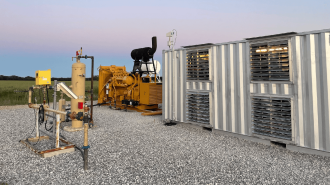Two college grads figured out how to make it big mining Bitcoin and simultaneously benefiting the environment.
The pair earned $4 million by mining the cryptocurrency with specialized shipping containers that use energy that would have been lost otherwise — the wasted flare gas that is a byproduct of oil extraction.
Recent Texas A&M grads Brent Whitehead and Matt Lohstroh teamed up to launch the company Giga Energy Solutions, which hitches shipping containers containing thousands of bitcoin-mining computers to natural gas wells. The containers pull excess natural gas to generators, which create electricity to power the miners, reports Coinspeaker.
“Growing up, I always saw flares, just being in the oil and gas industry. I knew how wasteful it was. It’s a new way to not only lower emissions but to monetize gas.”
Brent Whitehead
Why this matters: Cryptocurrency is under pressure from environmentalists and politicians to clean up its power usage. Mining the digital currency is surprisingly energy-intensive, and in most cases (though not all), fossil fuels are burned to create that electricity, contributing to global warming.
But as crypto comes under scrutiny for its environmental impact, the oil and gas industry has already taken its licks. Besides the environmental costs of burning fossil fuels, extracting them also contributes significantly to the industry’s emissions.
Seize the opportunity: Natural gas is routinely encountered by drillers looking for oil. Unfortunately, if the discovery site is far from the gas pipelines, the logistics of capturing and distributing the gas byproduct isn’t economical. So many companies burn it off instead.
In 2020, thousands of gas flares at oil drilling sites throughout the world burnt almost 142 billion cubic meters of gas, resulting in CO2-equivalent emissions of about 400 million tons.
But the pair behind Giga saw this wasted gas as an opportunity. With their shipping containers, they could drive their digital mining equipment out to the wells and harness the wasted gas to power the massive computers.
It’s a win-win: the natural gas is no longer wasted, instead, it goes toward the crypto-mining process negating the need for more fossil fuel extraction.
“Growing up, I always saw flares, just being in the oil and gas industry. I knew how wasteful it was,” Whitehead told CNBC. “It’s a new way to not only lower emissions but to monetize gas.”
Changing the trend: The oil and gas companies Whitehead initially approached with their shipping containers weren’t convinced right away. So the team had to get more creative. They took their shipping containers to small companies that couldn’t get the proper flare permits to comply with regulations and were wasting the gas. These companies can be small enough that they operate under the radar and get away with flaring without permits to do so.
“We were able to come in and say, ‘Hey, you’re flaring, and you shouldn’t be. You’re doing stuff that’s illegal, and you have opportunity here, because you have a shut-in well. We can take all this gas,'” said Whitehead.
According to Whitehead, his company currently has contracts with 20 oil and gas companies, and they are still building more specialized shipping containers. They are planning to expand their team of 11 by hiring more people.
Despite giving purpose to otherwise wasted gas and avoiding consuming power from the grid, the process does raise questions about the net environmental benefits. Could this be a way for oil and gas companies to enhance their green credentials in the eyes of the general public and investors? And if we are trying to move away from fossil fuels toward more green energy, will this be an additional profit source for fossil fuel companies?
We’d love to hear from you! If you have a comment about this article or if you have a tip for a future Freethink story, please email us at [email protected].






